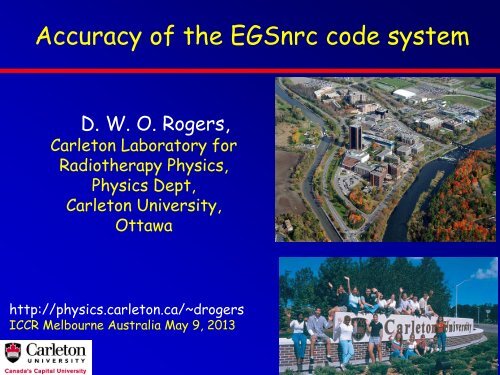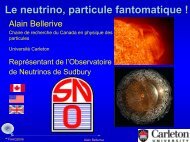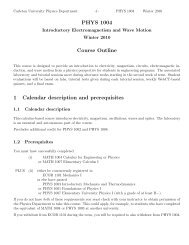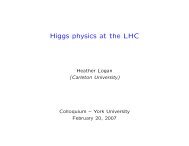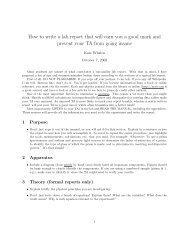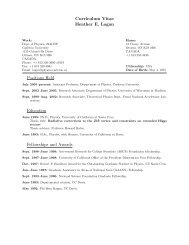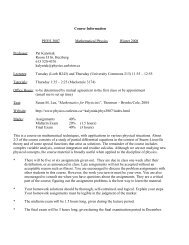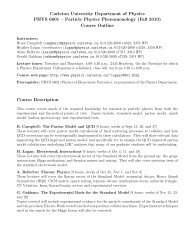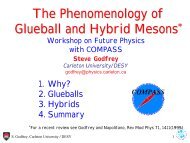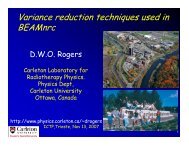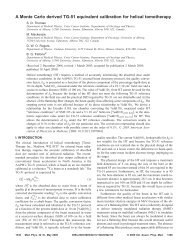Accuracy of the EGSnrc Monte Carlo Code System
Accuracy of the EGSnrc Monte Carlo Code System
Accuracy of the EGSnrc Monte Carlo Code System
Create successful ePaper yourself
Turn your PDF publications into a flip-book with our unique Google optimized e-Paper software.
1/47<br />
<strong>Accuracy</strong> <strong>of</strong> <strong>the</strong> <strong>EGSnrc</strong> code system<br />
D. W. O. Rogers,<br />
Carleton Laboratory for<br />
Radio<strong>the</strong>rapy Physics,<br />
Physics Dept,<br />
Carleton University,<br />
Ottawa<br />
http://physics.carleton.ca/~drogers<br />
ICCR Melbourne Australia May 9, 2013
2/47<br />
<strong>Accuracy</strong> and Limitations <strong>of</strong> <strong>EGSnrc</strong><br />
• Fano test<br />
• real ion chambers<br />
• k Q calculations<br />
• multiple scattering tests<br />
• backscatter data for x-rays and megavoltage<br />
• transmission test <strong>of</strong> extreme conditions<br />
• brachy<strong>the</strong>rapy spectra and dose rate constants
3/47<br />
How accurately can we calculate ion<br />
chamber response? The Fano test<br />
Fano’s <strong>the</strong>orem<br />
Under conditions <strong>of</strong> charged particle equilibrium <strong>the</strong><br />
electron fluence in a medium is independent <strong>of</strong> <strong>the</strong><br />
density.<br />
Fano cavity chamber,<br />
- full build up wall<br />
- cavity ei<strong>the</strong>r: gas <strong>of</strong> wall material or wall material<br />
- perfect CPE => no attenuation or scattered photons
4/47<br />
Fano test (cont)<br />
Consider <strong>the</strong> case with cavity <strong>of</strong> wall material<br />
but since, by Fano’s <strong>the</strong>orem <strong>the</strong> electron fluence<br />
is unchanged =><br />
and hence:<br />
where D gas is <strong>the</strong> dose to <strong>the</strong> gas without any<br />
attenuation and scatter (so <strong>the</strong>re is CPE) and D’ gas<br />
is <strong>the</strong> dose calculated with attenuation and scatter<br />
and <strong>the</strong>n corrected by <strong>the</strong> wall correction factor,<br />
i.e. K wall (not ano<strong>the</strong>r kerma!)
Fano test (cont)<br />
-cover <strong>of</strong><br />
<strong>EGSnrc</strong><br />
manual<br />
-against own<br />
cross sections<br />
60<br />
Co<br />
-ESTEPE is<br />
max fractional<br />
step size<br />
This is <strong>the</strong> toughest test I know for any<br />
electron-photon <strong>Monte</strong> <strong>Carlo</strong> code<br />
5/47
Fano test (cont)<br />
• with lead walls, <strong>EGSnrc</strong> passes at 0.1 % level in<br />
60<br />
Co (La Russa, Med Phys 35(2008) 5629).<br />
– No parameter adjustment needed<br />
-<br />
- Sempau and Andreo (PMB, 51 (2006) 3533-3548)<br />
achieved similar accuracy with PENELOPE (used<br />
different version <strong>of</strong> Fano test) as did Yi et al<br />
(Med Phys 33 (2006) 1213)<br />
- both cases needed adjustment <strong>of</strong> parameters<br />
- Poon et al (PMB 50 (2005) 681 - 694) showed that<br />
GEANT4 failed Fano test by as much as 39%.<br />
- now within 1% at expense <strong>of</strong> long CPU times<br />
(Sawakuchi, private communication)<br />
6/47
7/47<br />
Fano test (cont)<br />
• <strong>the</strong> Fano test assesses accuracy against its own<br />
cross sections.<br />
– If cross sections are wrong, test can still be<br />
passed if mass energy absorption coefficients<br />
are calculated with same cross sections.<br />
• real test is against measured ion chamber data.
eal chambers in 60 Co beams<br />
1958<br />
1957<br />
1954<br />
1992<br />
2007<br />
La Russa & Rogers Med Phys 35 (2008) 5629-5640<br />
8/47
Whyte: variation <strong>of</strong> pressure/wall<br />
• Co-60 beam<br />
• data normalized<br />
only once<br />
•i.e. relative<br />
values are<br />
meaningful<br />
•depends on<br />
cross sections<br />
• RMSD = 0.5%<br />
Med Phys 35 (2008) 5629-5640<br />
9/47
Nilsson et al: wall variations<br />
• 60 Co<br />
•normalized to<br />
polystyrene<br />
chamber<br />
•RMSD=1.4%<br />
(<strong>EGSnrc</strong>/expt)<br />
•depends on<br />
cross-sections<br />
Med Phys 35 (2008) 5629-5640<br />
10/47
What affects <strong>the</strong> calculation?<br />
against<br />
measured<br />
data<br />
Kawrakow & Rogers, MC2000, p135 based on data <strong>of</strong><br />
Nilsson et al, Med Phys 19(1992)1413<br />
11/47
Burns: variation <strong>of</strong> graphite chamber<br />
• 60 Co<br />
• RMSD = 0.03%<br />
• (0.7% overall<br />
variation)<br />
La Russa Med Phys 35 (2008) 5629-5640<br />
12/47
13/47<br />
Response vs angle <strong>of</strong> pancake chamber<br />
R/A wall should be<br />
constant.<br />
It is, within 0.3%<br />
despite 8%<br />
variation.<br />
(residual 0.3% is a<br />
K an effect)<br />
McCaffrey et al PMB 49(2004) 2491
14/47<br />
ab initio <strong>Monte</strong> <strong>Carlo</strong> calculations <strong>of</strong><br />
k Q for clinical ion chambers<br />
• Fano test is usually for simple `in air’ ion chambers<br />
• real interest is `in-phantom’<br />
• egs_chamber code <strong>of</strong> Wulff et al (Med Phys 35<br />
(2008) 1328)<br />
– very efficient: correlated sampling<br />
– handles complex realistic geometries<br />
A12<br />
NE2571
15/47<br />
Calculating k Q (protocol clinical<br />
dosimetry)<br />
• definitions:<br />
assume (W/e)<br />
is independent<br />
<strong>of</strong> beam<br />
quality
16/47<br />
9 different “classes” <strong>of</strong> detectors<br />
black:TG51<br />
gold: fit<br />
labels:(wall/<br />
electrode)<br />
Note large<br />
effects <strong>of</strong><br />
high-Z<br />
electrodes
17/47<br />
Uncertainties on calculated k Q<br />
• <strong>EGSnrc</strong> is accurate to 0.1 % against its own cross sections<br />
• what are effects <strong>of</strong> cross section uncertainties?<br />
– are <strong>the</strong>y correlated or not?<br />
• probably correlated for megavoltage photons<br />
• what is uncertainty on (W/e) air being constant?<br />
– TRS-398 says 0.5% but evidence for any value is very<br />
thin
18/47<br />
Cross section uncertainties on k Q<br />
standard error propagation, assuming uncorrelated<br />
where u(x i ) is <strong>the</strong> uncertainty on cross section x i<br />
Approximate<br />
where<br />
is change in k Q when i-th cross section is<br />
changed by .<br />
Calculate for a corresponding to u(x i ).
Uncertainties on k Q for all chambers<br />
correlated or uncorrelated<br />
worst case: 0.39% 0.86% 0.63% 0.99%<br />
Muir & Rogers Med Phys 37 (2010) 5939<br />
19/47
Experimental measurements <strong>of</strong> k Q<br />
• many measurements done, but most papers<br />
measure one or two types <strong>of</strong> chambers<br />
• McEwen measured k Q for 27 different types<br />
against <strong>the</strong> Canadian primary standards <strong>of</strong><br />
absorbed dose using ----><br />
(Med. Phys. 37 (2010) 2179)<br />
• for “well-behaved” chambers<br />
measurement uncertainty on k Q was 0.30%<br />
• agreement with TG—51 values is excellent,<br />
typically 0.5% or better for “well-behaved”<br />
20/47
Consistency <strong>of</strong> measured k Q<br />
diamonds are<br />
from standards<br />
labs (Stucki et<br />
al, to be<br />
published)<br />
0.3%<br />
NE2571<br />
Muir et al Med Phys 38 (2011) 4600<br />
21/47
How well do calculations and<br />
measurements agree?<br />
For 26 chambers in common,<br />
-χ 2 /df < 0.65 for all chambers at 1 energy<br />
- χ<br />
2 /df < 1 for all chambers vs energy except 1<br />
Suggests, if anything, uncertainties are too large<br />
http://www.physics.carleton.ca/clrp/kQ<br />
22/47
23/47<br />
Measured vs calculated k Q<br />
26 chambers<br />
in common<br />
shaded part is<br />
less precise<br />
chambers<br />
remarkable<br />
agreement
24/47<br />
Backscatter coefficients<br />
• e - backscatter is <strong>the</strong> most difficult physical quantity<br />
for <strong>Monte</strong> <strong>Carlo</strong> to calculate<br />
– unfortunately it is also hard to measure accurately<br />
• it is defined as <strong>the</strong> number <strong>of</strong> e- reflected from a<br />
surface per incident e- (above a low energy cut<strong>of</strong>f,<br />
about 50 eV to exclude secondary electron emission<br />
from <strong>the</strong> surface)
Backscatter - a tough test: kilovolts<br />
experimental data scatter about calculated values<br />
Ali & Rogers PMB 53(2008) 1527-1543<br />
25/47
Backscatter - spectra<br />
Ali & Rogers J Phys D: App Phys 41 (2008)055505<br />
26/47
27/47<br />
Backscatter: megavolts<br />
Ali et al, in preparation
<strong>Accuracy</strong> <strong>of</strong> multiple scattering<br />
Multiple scattering is a dominant physical effect for e-<br />
<strong>EGSnrc</strong> uses a multiple scattering <strong>the</strong>ory developed by<br />
Kawrakow (NIMB 134 (1998) 325-336)<br />
It has <strong>the</strong> advantage <strong>of</strong> seamlessly converting into a<br />
single scattering <strong>the</strong>ory for very short steps.<br />
Recently <strong>the</strong>re have been some high quality<br />
measurements done by my ex-colleagues at NRC to test<br />
<strong>the</strong> <strong>the</strong>ory as implemented in <strong>EGSnrc</strong><br />
Ross et al, Med Phys 35 (2008)4121 - 4131<br />
i<br />
28/47
NRC experimental setup<br />
Med Phys 35 (2008)4121 - 4131<br />
29/47
NRC’s results<br />
symbols: expt<br />
lines: <strong>EGSnrc</strong><br />
symbols: expt<br />
lines: <strong>EGSnrc</strong><br />
Note <strong>the</strong> experiment is slightly wider than calculations<br />
Thanks to Malcolm McEwen for <strong>the</strong> raw data<br />
Med Phys 35 (2008) 4121 - 4131<br />
30/47
NRC’s results for q 1/e widths<br />
Experimental<br />
uncertainty<br />
about 1 %.<br />
each bar is a measurement with a different thickness foil<br />
Ross et al Med Phys 35 (2008) 4121 - 4131<br />
31/47
Transmission analysis<br />
e -<br />
target<br />
collimator<br />
attenuator<br />
collimator<br />
detector<br />
Goal <strong>of</strong> project was accurate determination <strong>of</strong> brem spectra<br />
from linac beams. Also provides a very stringent benchmark.<br />
Ali et al Med. Phys. 39 (2012) 5990<br />
32/47
33/47<br />
Attenuator rack<br />
graphite<br />
lead
Uncertainty budget on T(d,x i )<br />
• 10 MV much worse since low energy limit <strong>of</strong> machine<br />
• take into account<br />
– short term drifts < 0.15% P pol < 0.15%<br />
– leakage < 0.1% P ion < 0.03%<br />
– Monitor stability 0.1%<br />
– attenuator thickness
35/47<br />
A problem<br />
• <strong>the</strong> calculated transmission was wrong by up to 7%<br />
compared to <strong>the</strong> 0.64% experimental measurements.<br />
• attenuation by a factor <strong>of</strong> 100 is very sensitive to<br />
errors in cross section.<br />
– consider a monoenergetic case<br />
• T=0.01 => e -mx = 0.01 but say m should be 1.01m<br />
and hence T = e -1.01mx = (e -mx ) 1.01 = 0.095<br />
i.e. a 1% error causes a 5% change in T<br />
• what about photonuclear interactions?
36/47<br />
photonuclear cross sections<br />
(γ,n) + (γ,p)<br />
from E Ali<br />
PhD <strong>the</strong>sis
Effects <strong>of</strong> photonuclear interactions<br />
Ali added<br />
photonuclear<br />
attenuation<br />
(no energy<br />
deposition) into<br />
<strong>EGSnrc</strong><br />
case shown is<br />
worst case since<br />
high energy<br />
analytic vs <strong>Monte</strong> <strong>Carlo</strong> as check on implementation<br />
37/47
Aside: photonuclear effects on a<br />
clinical spectrum<br />
from E Ali (unpublished)<br />
38/47
Direct comparisons <strong>of</strong> transmission data<br />
Symbols <br />
different<br />
target/energy<br />
combinations.<br />
x is 10 MV/Al<br />
0.4% cross<br />
section change<br />
can explain all<br />
discrepancies<br />
within<br />
uncertainties.<br />
Do data tie down uncertainties on Xsections?<br />
39/47
40/47<br />
Calculation vs measurement<br />
(ratios <strong>of</strong> T different targets,detectors,attenuators)<br />
remarkable<br />
agreement<br />
uncertainties<br />
from photon<br />
cross sections<br />
drop out <strong>of</strong><br />
ratios (same in<br />
both)
41/47<br />
Transmission: a very tough benchmark for<br />
<strong>Monte</strong> <strong>Carlo</strong> codes<br />
• <strong>the</strong>se data are a very stringent test <strong>of</strong> any MC<br />
code system<br />
– had to re-engineer XCOM cross sections<br />
– add photonuclear attenuation<br />
– use KM brem angular sampling ra<strong>the</strong>r than<br />
“simple” option in <strong>EGSnrc</strong><br />
• <strong>the</strong>re is a report with all <strong>the</strong> data required to do a<br />
detailed comparison with Geant4, PENELOPE,<br />
MCNP.
42/47<br />
Brachy<strong>the</strong>rapy benchmarks<br />
• <strong>Monte</strong> <strong>Carlo</strong> plays an essential role in brachy<strong>the</strong>rapy<br />
dosimetry<br />
– calculates TG-43 parameters such as g(r), F(r,q),<br />
L (dose rate constant)<br />
• very hard to confirm <strong>the</strong>se calculations with much<br />
accuracy as experiments have large uncertainties (5%).<br />
• <strong>the</strong>re have been teams measure spectra from multiple<br />
seeds with reasonable consistency
125<br />
I spectra (calculated)<br />
based on Rodriguez Med Phys 40(2013) 011713<br />
43/47
Calculated vs measured branching ratios<br />
Agreement<br />
about same<br />
as variations<br />
in expt.<br />
0.264 0.071 1.0 0.250 0.068<br />
0.260 0.069 1.0 0.249 0.0675<br />
Same for 20<br />
seeds total<br />
0.0 0.0 1.0 0.250 0.068<br />
Rodriguez and Rogers Med Phys 40(2013) 011713<br />
44/47
What about measured vs calculated dose<br />
rate constants?<br />
• TG-43 and its updates recommend averaging<br />
calculated and measured values <strong>of</strong> L<br />
• this is because <strong>the</strong>re is a systematic difference<br />
between <strong>the</strong>m <strong>of</strong> 4.6% for 125 I as published.<br />
• Problems:<br />
– intrinsic energy dependence <strong>of</strong> <strong>the</strong> TLDs used in<br />
<strong>the</strong> measurements was not properly accounted<br />
for (an 8.2% effect relative to 60 Co)<br />
– relative absorbed dose energy dependence <strong>of</strong><br />
<strong>the</strong> different sizes <strong>of</strong> TLD chips used needed to<br />
be accounted for (a 2.7% effect)<br />
• properly accounting for <strong>the</strong>se, average difference<br />
for 22 measurements for 17 seeds drops to 0.8%<br />
45/47
46/47<br />
Conclusions<br />
• The <strong>EGSnrc</strong> code system is capable <strong>of</strong> accurately<br />
simulating a wide variety <strong>of</strong> experimental<br />
benchmarks<br />
• By testing any computer code system we<br />
constantly are forced to make improvements<br />
– e.g. adding photonuclear attenuation and<br />
reworking <strong>the</strong> use <strong>of</strong> <strong>the</strong> XCOM cross sections
47/47<br />
Thank you for your attention <br />
• much <strong>of</strong> <strong>the</strong> work was done by students and colleagues<br />
– Elsayed Ali, Bryan Muir, Dan La Russa, Manuel<br />
Rodriguez and Rowan Thomson at Carleton University<br />
– <strong>the</strong> k Q experiments were in conjunction with NRC’s<br />
Malcolm McEwen<br />
– <strong>EGSnrc</strong> and BEAMnrc systems have been developed<br />
and maintained by colleagues at NRC over <strong>the</strong> years<br />
• Iwan Kawrakow, Ernesto Mainegra-Hing,<br />
Blake Walters, Frederic Tessier<br />
-work supported by a Vanier Scholarship, and NSERC CGS,<br />
OGSSTs, <strong>the</strong> CRC program, an NSERC DG, CFI and OIT
em yield from thick targets<br />
Faddegon et al Med Phys 17 (1990) 773 and<br />
Med Phys 18 (1991) 727<br />
measured brem yield as a function <strong>of</strong> energy and angle<br />
for many different target materials and compared <strong>the</strong>ir<br />
results to EGS4 calculations.<br />
Typical experimental uncertainty: 5%<br />
Faddegon et al Med Phys 35(2008) 4308 compared same<br />
measured data to 3 <strong>Monte</strong> <strong>Carlo</strong> codes:<br />
<strong>EGSnrc</strong>, GEANT4 and PENELOPE<br />
48/47
em total yield vs incident energy<br />
thick targets<br />
5% uncertainty<br />
on<br />
measurements<br />
photons<br />
> 220 keV<br />
Faddegon et al Med Phys 35 (2008) 4308<br />
49/47
em yield vs angle at 15 MV<br />
thick<br />
targets<br />
photons<br />
> 145 keV<br />
Note: yield<br />
at 90 o is<br />
very small<br />
Med Phys 35 (2008) 4308<br />
50/47
60<br />
Co <strong>the</strong>rapy unit<br />
Issued<br />
June 17,<br />
1988<br />
Thanks to<br />
Jerry Battista<br />
51/47
Simulating an Eldorado6<br />
Mora et al Med Phys 26(1999) 2494<br />
52/47
Output variation vs expt<br />
Med Phys 26(1999) 2494<br />
53/47
10 & 20 MV beams from NRC linac<br />
NRC research<br />
accelerator,<br />
everything is known<br />
about it, including<br />
incident electron<br />
beam energy.<br />
Ion chamber<br />
measurements.<br />
A systematic<br />
problem near<br />
surface<br />
Sheikh-Bagheri et al Med Phys 27(2000) 2256–2266<br />
54/47
LaRussa et al: variation <strong>of</strong> pressure<br />
x-ray beams<br />
• experiment = solid line<br />
• <strong>EGSnrc</strong> = dashed line<br />
• Calculated results generally within 0.5%.<br />
Med Phys 34 (2007) 4690<br />
55/47


